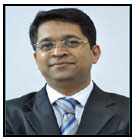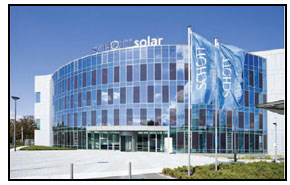 -Amit Barve, General Manager - Solar,
SCHOTT Glass India Pvt Ltd
SCHOTT Solar AG
-Amit Barve, General Manager - Solar,
SCHOTT Glass India Pvt Ltd
SCHOTT Solar AG is a wholly-owned subsidiary of CHOTT AG and
has a long history of 52 years in manufacturing components for
solar industry with presence in solar photovoltaic well as solar
thermal plants. SCHOTT Solar has been actively involved with local
presence in Indian market for the past five years with offices in
Mumbai and Pune.
Amit Barve tells
Venugopal Pillai about
SCHOTT Solar's plans in the light of India's solar power ambitions.
To start with, please tell us about the various services that
SCHOTT Solar offers in the solar power space.
SCHOTT Solar is an internationally operating manufacturer of
high-quality solar products headquartered in Mainz, Germany.
The company has more than 50 years of experience in solar
technology and operates in two business segments. In the
photovoltaic business segment, SCHOTT Solar produces solar
wafers and solar cells as well as crystalline silicon modules and
thin film modules. In the concentrated solar power business
segment, the Company manufactures receivers for solar power
plants with parabolic trough technology and is the worldwide
market and technology leader in this field. SCHOTT Solar owns
production facilities in Germany, Spain, USA, China and in the
Czech Republic. Moreover, SCHOTT Solar has sales offices in all
major markets. As a wholly-owned subsidiary the company also
benefits from the international network of the SCHOTT Group,
which employs close to 17,500 employees worldwide and
generated sales of approximately 2.9 billion euros in the fiscal
year 2009-10.
Tell us more about the new mono solar module that SCHOTT Solar
plans to launch in 2012. Will it find applications in the Indian
market?
The new mono-crystalline solar cell that our researchers have
succeeded in developing in the industrial format of 156 x 156 mm
offers efficiency of over 20 per cent for the first time ever. We
feel this demonstrates quite clearly how an industry leader like
SCHOTT Solar is capable of applying the expertise it has gained
in more than three decades of development work on multicrystalline
solar cells to mono-crystalline wafers as well. We are
extremely excited about the prospects of being able to offer our
customers all over the world such high efficiency rates. Indian
customers are certainly welcome to explore the potential that
our new module offers them. After all, relying on innovations that
offer the highest possible performance is key to achieving high
energy yields over the long term.
What are the major projects executed by SCHOTT Solar in India so
far? India's National Solar Mission envisages a huge 1 GW of solar installations by 2013. How does SCHOTT Solar plan to tap into this
big opportunity?
In the area of photovoltaics, Premier Solar India and SCHOTT
Solar signed a contract to have 20 mw installed by their new EPC
division, Premier Solar Power Tech, as part of a grid-connected
ground mount system just a few months ago. This PV system will
generate enough solar energy for more than 40,000 households.
With respect to CSP, an industry we feel is preparing to take off in
India. It is certainly worth mentioning that SCHOTT Solar has
already supplied more than 600,000 receivers for solar power
plants that use parabolic trough technology in many different
regions of the world. Prime examples include the Andasol CSP
plants in Spain and Nevada Solar One in the US.
 We get a feeling that prices of solar photovoltaic equipment,
mainly cells and modulesm have dropped over the recent years?
What is your view?
We get a feeling that prices of solar photovoltaic equipment,
mainly cells and modulesm have dropped over the recent years?
What is your view?
Yes, that is quite correct, and SCHOTT Solar AG too has not
remained untouched by the problem of global overcapacities in the
solar market. Yet we have successfully demonstrated our power
of innovation time and again - just recently by setting two world
records at the same time at the PVSEC show and by announcing
the new, high-performance MONO module. We are prepared to
compete and firmly believe that we will continue to rank among the
advanced companies in the PV industry in the future.
In very general terms, please tell us about the two principle modes
of solar power generation-photovoltaic and solar thermal. In
terms of efficiency and capital costs, how do they compare?
Concentrated Solar Power (CSP) technology is particularly wellsuited
for large-scale applications. CSP technology essentially
converts sunlight into heat using parabolic trough power plants
that consist of large rows of parabolic-shaped mirrors that
concentrate solar radiation by as many as 80 times onto the
receivers. As it heats up, a special heat-transfer oil is transported
by a heat exchanger so it can create steam that drives traditional
steam turbines. Thermal accumulators then see to it that
electricity remains available, even at night.
Photovoltaics on the other hand refers to a method of
generating electrical power by converting solar radiation into
direct current electricity. Photovoltaic power generation relies on
solar panels that consist of a number of solar cells that contain a
photovoltaic material, mono-crystalline silicon, polycrystalline
silicon, or amorphous silicon, for instance.
Due to the fact that these two technologies address different
needs, it is difficult to compare them.
We understand that the commercial feasibility of solar power
plants depends a great deal on government incentives. In this
reckoning, how sustainable is the industry on a long-term basis?
It is the declared goal of the solar industry to advance solar power
to the point at which it will be able to compete with conventional
sources of energy. In order to achieve this objective, solar
manufacturers all over the world are working very hard to lower
their production costs and, at the same time, significantly increase
the efficiency of their modules. Funding instruments like feed-in
tariffs can clearly be justified as a way of lowering our dependence
on fossil fuels and protecting the environment in the near future,
especially considering the significant progress that is being made
in this area.
 Does SCHOTT Solar eventually intend to set up a manufacturing
facility in India?
Does SCHOTT Solar eventually intend to set up a manufacturing
facility in India?
It is hardly a secret that the global solar industry is currently faced
with the problem of overcapacities, therefore priority should be
given to utilizing existing capacities as effectively as possible.
Nevertheless, India shows a very promising development
regarding solar. We are watching the development of the Indian
market very closely and will then make a decision appropriately.
Which countries currently account for a majority of your
company's global revenues?
The German market is still go be the biggest one in 2012. Germany
might be followed by Italy and then by US, UK, France and Spain.
Outside Europe, we expect for example Israel, Australia and last
but not least, India, to show an interesting development.
What has been SCHOTT Solar's experience over the past five years
in India, and how does the future look to you?
Like India's ambitious growth plans, SCHOTT Solar is quite excited
by the dynamic developments that have been taking place in India
over the last few years. SCHOTT solar has also been growing
consistently for last five years in India with growth in industry and
now with arrival of the Jawaharlal Nehru National Solar Mission,
we expect that India can take its place among the top drivers of
solar growth.